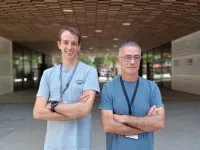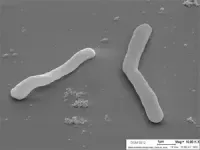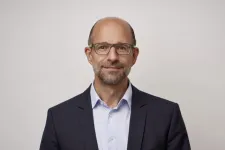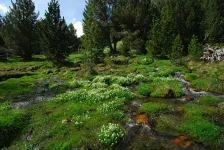(Press-News.org) Sant Pau researchers discover a new gene that causes ALS
Researchers from the Neuromuscular Diseases Group and the Dementia Neurobiology Group of the Sant Pau Research Institute (IR Sant Pau) and the Memory Unit of the Sant Pau Hospital, led by neurologist Dr. Ricard Rojas-García, have identified a new mutation in the ARPP21 gene that could be the cause of Amyotrophic Lateral Sclerosis (ALS), a devastating neurodegenerative disease.
Specifically, it is a shared mutation (c.1586C>T; p.Pro529Leu) in the ARPP21 gene that codes for an RNA-binding protein and has been found in a total of 10 ALS patients from 7 unrelated families in a region in the southeast of the autonomous community of La Rioja.
The investigation was initiated after detecting an unusually high number of ALS cases in La Rioja, specifically in the southeast region of the autonomous community. The number of cases identified in the area, particularly familial, and the calculated minimum incidence considerably exceeded the number of cases expected during the study period given the usual incidence data, which are usually between two and three cases per 100,000 inhabitants annually.
“We noticed that there were many patients from this area, from very close towns, which attracted a lot of attention,” explains Dr. Ricard Rojas-García, researcher in the Neuromuscular Diseases Group of the IR and one of the main authors of the study.
Between 5% and 10% of ALS cases have a family history of the disease, and in 30% of these cases, an underlying genetic cause could not be identified after extensive study of known related genes to this day with ALS. The aim of the Sant Pau researchers was to identify new genes related to ALS in cases where the genetic tests were negative, motivated by a significantly increased incidence of ALS in this small geographical region of Spain.
The scientists performed whole-genome sequencing on a group of 12 ALS patients (5 of them with a family history) from this unique area. The study was expanded to include members of affected families and additional cases from a wider surrounding region. The mutation identified in ARPP21 had not been found in other ALS-causing genes. This finding strongly suggests that ARPP21 is a novel ALS-causing gene.
The southeastern region of the community of La Rioja is an area of 1219.42 km². Between 2009 and 2022, it had an average population of 43,433, of which 31,324 were over 18 years of age. The population density was 35.62 inhabitants/km². This is an area with a high rate of emigration, so there may be cases in the rest of the State.
Given an average incidence of ALS of 1.4–2.47 cases/100 000 people/year, we calculated an expected number of cases of 0.44–0.77 per year in this area, equivalent to 5-10 patients during the study period (2009-2022). With reference to familial ALS cases, assuming a frequency of 5-10%, the expected number of cases in the area would be 0.02-0.08 cases/year or one new case every 12.5- 50 years
Despite this, between 2009 and 2022, 15 patients from the study area who met the diagnostic criteria for ALS were visited in Sant Pau. 7 of 15 (46.6%) had a family history of ALS and were considered as possible familial cases. Known disease-causing mutations were ruled out by exome sequencing analysis or a custom gene panel.
“This mutation will not only help diagnose ALS more precisely, but also opens the door to researching new personalized therapies and studying the function of this protein in the disease,” adds Dr. Oriol Dols-Icardo, researcher in the Neurobiology of Dementia group and the Memory Unit at IR Sant Pau and first signatory of the study.
Dr. Dols-Icardo believes that these findings could open new avenues for the diagnosis and treatment of ALS. The identification of ARPP21 as a causative gene underscores the importance of continued research in specific geographic areas to discover new genetic factors.
GLOBAL IMPLICATIONS
Although this discovery has been made in a specific region of Spain, the researchers believe that it could have global implications. “This opens the door for other research teams worldwide to review their databases and patients to see if this mutation is also present elsewhere,” they explain.
The discovery of the new gene associated with ALS will not only allow for better diagnosis and genetic counseling for affected families, but also opens up new avenues of research into the functioning of this specific protein and its relationship to the disease.
This advance highlights the importance of genetic research in the understanding and treatment of rare diseases and highlights the need to continue exploring the genetic causes of ALS to be able to develop more effective treatments in the future.
END
Sant Pau researchers discover a new gene that causes ALS
A study by Sant Pau Research Institute (IR Sant Pau) identified a new gene associated with amyotrophic lateral sclerosis (ALS)
2024-07-12
ELSE PRESS RELEASES FROM THIS DATE:
Synthetic biology reveals the secrets of life without oxygen
2024-07-12
Long before photosynthesis brought free oxygen into the world, the earth was already populated by numerous organisms. Oxygen was life-threatening for them and therefore they developed completely different metabolic pathways to those we know from plants, animals and humans. Anaerobic bacteria have survived the ages in special, oxygen-free niches, some of them very close to us: as an essential part of the intestinal microbiome, where they are of enormous importance for the well-being of the organism. However, certain anaerobes can ...
UC3M student startup, Solaris Vita, awarded in Europe's largest entrepreneurship competition
2024-07-12
Solaris Vita, a startup created by students at Universidad Carlos III de Madrid (UC3M), has won second place in the "Innovation of the Year" category at Gen-E 2024, the largest European youth entrepreneurship competition, organized by Junior Achievement Europe. This is the first time that a Spanish university team has won this award.
The promoters of Solaris Vita, Miguel Iglesias (Industrial Engineering graduate from UC3M) and Yann Guichard (Economics student at the University), competed ...
How plant cold specialists can adapt to the environment
2024-07-12
Plant cold specialists like the spoonworts have adapted well to the cold climates of the Ice Ages. As cold and warm periods alternated, they developed a number of species that also resulted in a proliferation of the genome. Evolutionary biologists from the universities of Heidelberg, Nottingham, and Prague studied the influence this genome duplication has on the adaptive potential of plants. The results show that polyploids – species with more than two sets of chromosomes – can have an accumulation of structural mutations with signals for a possible local ...
Biomarkers reveal how patients with glaucoma may respond to treatment
2024-07-12
Markers in the blood that predict whether glaucoma patients are at higher risk of continued loss of vision following conventional treatment have been identified by researchers at UCL and Moorfields Eye Hospital.
Over 700,000 people in the UK have glaucoma and it is the leading cause of irreversible blindness worldwide. The condition occurs when the cells in the eye that help you see (called retinal ganglion cells) start to die.
The main risk factors for glaucoma are high eye pressure and older age.
Currently, all licenced treatments are designed to lower pressure in the eye – also known as intraocular pressure. However, some patients ...
Microbeads with adaptable fluorescent colors from visible light to near-infrared
2024-07-12
1. A research team at NIMS has successfully developed an environmentally friendly, microspherical fluorescent material primarily made from citric acid. These microbeads emit various colors of light depending on the illuminating light and the size of the beads, which suggests a wide range of applications. Furthermore, the use of plant-derived materials allows for low-cost and energy-efficient synthesis.
2. Conventional luminescent devices commonly utilized thin films of compound semiconductors containing metals or sintered inorganic materials with rare earth elements. However, in a circular economy, there ...
Neighborhood disadvantage and prostate tumor RNA expression of stress-related genes
2024-07-12
About The Study: In this cross-sectional study, the expression of several stress-related genes in prostate tumors was higher among men residing in disadvantaged neighborhoods. This study is one of the first to suggest associations of neighborhood disadvantage with prostate tumor RNA expression. Additional research is needed in larger studies to replicate findings and further investigate interrelationships of neighborhood factors, tumor biology, and aggressive prostate cancer to inform interventions to reduce disparities.
Corresponding Author: To contact the corresponding author, ...
Screen media use and mental health of children and adolescents
2024-07-12
About The Study: This secondary analysis of a randomized clinical trial found that a short-term reduction in leisure-time screen media use within families positively affected psychological symptoms of children and adolescents, particularly by mitigating internalizing behavioral issues and enhancing prosocial behavior. More research is needed to confirm whether these effects are sustainable in the long term.
Corresponding Author: To contact the corresponding author, Jesper Schmidt-Persson, Ph.D., email jesp@kp.dk.
To ...
Mediterranean diet and cardiometabolic biomarkers in children and adolescents
2024-07-12
About The Study: The findings of this study suggest that Mediterranean diet-based interventions may be useful tools to optimize cardiometabolic health among children and adolescents.
Corresponding Author: To contact the corresponding author, Jose Francisco Lopez-Gil, Ph.D., email josefranciscolopezgil@gmail.com.
To access the embargoed study: Visit our For The Media website at this link https://media.jamanetwork.com/
(doi:10.1001/jamanetworkopen.2024.21976)
Editor’s Note: Please see the article for additional information, including other authors, author contributions ...
A chemical claw machine bends and stretches when exposed to vapors
2024-07-12
Scientists at King Abdullah University of Science and Technology (KAUST) in Saudi Arabia have developed a tiny “claw machine” that is able to pick up and drop a marble-sized ball in response to exposure to chemical vapors.
The findings, published July 12 in the journal Chem, point to a technique that can enable soft actuators—the parts of a machine that make it move—to perform multiple tasks without the need for additional costly materials. While existing soft actuators can be “one-trick ponies” restricted to one type of movement, this novel composite film contorts itself ...
Living in disadvantaged neighborhoods influences stress-related genes, which may contribute to aggressive prostate cancer in African American men
2024-07-12
BALTIMORE, MD, July 12, 2024 — Those living in disadvantaged neighborhoods have significantly higher activity of stress-related genes, new research suggests, which could contribute to higher rates of aggressive prostate cancer in African American men. The study, which was co-led by the University of Maryland School of Medicine (UMSOM) and Virginia Commonwealth University (VCU), was published today in JAMA Network Open.
African American men have a higher incidence of prostate cancer and are more than twice as likely to die from the disease than White men in the U.S. They are often diagnosed with an ...
LAST 30 PRESS RELEASES:
Eye for trouble: Automated counting for chromosome issues under the microscope
The vast majority of US rivers lack any protections from human activities, new research finds
Ultrasound-responsive in situ antigen "nanocatchers" open a new paradigm for personalized tumor immunotherapy
Environmental “superbugs” in our rivers and soils: new one health review warns of growing antimicrobial resistance crisis
Triple threat in greenhouse farming: how heavy metals, microplastics, and antibiotic resistance genes unite to challenge sustainable food production
Earthworms turn manure into a powerful tool against antibiotic resistance
AI turns water into an early warning network for hidden biological pollutants
Hidden hotspots on “green” plastics: biodegradable and conventional plastics shape very different antibiotic resistance risks in river microbiomes
Engineered biochar enzyme system clears toxic phenolic acids and restores pepper seed germination in continuous cropping soils
Retail therapy fail? Online shopping linked to stress, says study
How well-meaning allies can increase stress for marginalized people
Commercially viable biomanufacturing: designer yeast turns sugar into lucrative chemical 3-HP
Control valve discovered in gut’s plumbing system
George Mason University leads phase 2 clinical trial for pill to help maintain weight loss after GLP-1s
Hop to it: research from Shedd Aquarium tracks conch movement to set new conservation guidance
Weight loss drugs and bariatric surgery improve the body’s fat ‘balance:’ study
The Age of Fishes began with mass death
TB harnesses part of immune defense system to cause infection
Important new source of oxidation in the atmosphere found
A tug-of-war explains a decades-old question about how bacteria swim
Strengthened immune defense against cancer
Engineering the development of the pancreas
The Journal of Nuclear Medicine ahead-of-print tip sheet: Jan. 9, 2026
Mount Sinai researchers help create largest immune cell atlas of bone marrow in multiple myeloma patients
Why it is so hard to get started on an unpleasant task: Scientists identify a “motivation brake”
Body composition changes after bariatric surgery or treatment with GLP-1 receptor agonists
Targeted regulation of abortion providers laws and pregnancies conceived through fertility treatment
Press registration is now open for the 2026 ACMG Annual Clinical Genetics Meeting
Understanding sex-based differences and the role of bone morphogenetic protein signaling in Alzheimer’s disease
Breakthrough in thin-film electrolytes pushes solid oxide fuel cells forward
[Press-News.org] Sant Pau researchers discover a new gene that causes ALSA study by Sant Pau Research Institute (IR Sant Pau) identified a new gene associated with amyotrophic lateral sclerosis (ALS)







